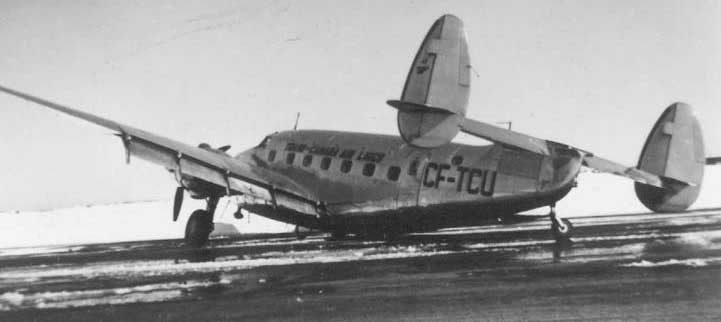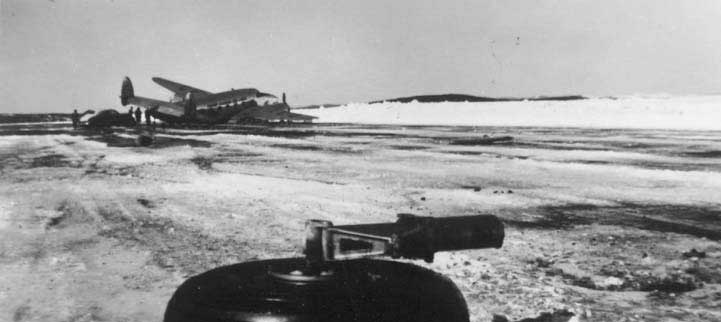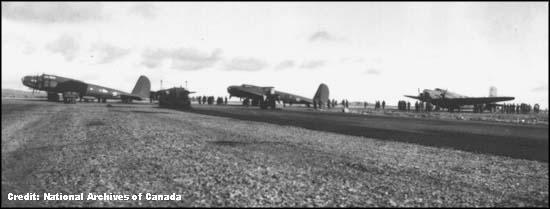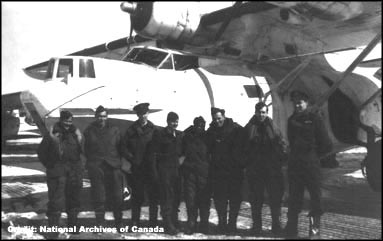|
|
|
A typical month for an RCAF
Aircrew at Torbay between 1941-1945 |
|
|
|
|
|


Another Hudson loses a wheel in an early landing at Torbay Airport.
Thanks to The Torbay
Museum for the photos above.
|
Recognizing the need for local defense measures and convoy protection in the North
Atlantic, the Canadian Government agreed late in 1940 to construct an air base near St.
John's. By year's end surveys had been completed and a site chosen near the coastal
community of Torbay to accommodate Royal Canadian Air Force (RCAF) operations. Early in
1941, Canadian Prime Minister and Secretary of State for External Affairs, W.L. Mackenzie
King, informed Newfoundland Governor Sir
Humphrey Walwyn of the intended location. Newfoundland agreed, stipulating however,
that Canada assume all expenses and that the aerodrome not be used for civil purposes
without Newfoundland's permission. Canada consented and in April 1941 McNamara
Construction Company began runway construction. Despite the difficulties presented by peat
bog and rock formations, work progressed rapidly during the summer and fall of 1941.
On 18 October 1941, three American B-17 Flying Fortresses and one RCAF Digby made the
first landing - albeit unofficial - on the only serviceable runway. Later that month a
British Overseas Airways Corporation B-24 Liberator en route from Prestwick, Scotland, to
Gander, made the first officially sanctioned landing during a weather emergency. Poor
conditions at Gander and along the eastern seaboard had necessitated a diversion to the
new aerodrome. As the airport lacked instrument landing aids at the time, the pilot,
Captain S.T.B. Cripps, used local radio station VONF as a homing beacon. The aircraft
suffered minor nose wheel damage on landing but no injuries to its five crew and fifteen
passengers including Major General Price Montague, Colonel J.L. Ralston, Canadian Minister
of National Defense, and Major General H.D.G. Crerar, Chief of the General Staff. The less
"celebrated" of the remaining passengers overnighted at Hotel Newfoundland in
cots placed in the dining room balcony.

First landing at Torbay air base, 18 October 1941
November 1941 witnessed the arrival of No. 11 Bomber Reconnaissance (BR) Squadron, the
first RCAF Squadron to take up duties at the now operational air base. The following month
Squadron Leader A.H. Cocking was attached on temporary duty as, evidently, the station's
first Commanding Officer. Squadron Leader W.C. Van Camp replaced Cocking in January 1942
and assumed command of both the station and 11 (BR) Squadron. From May 1942 until war's
end in 1945, RCAF Station Torbay was commanded by Newfoundland born Group
Captain Roy S. Grandy.
A typical month for aircrew at Torbay during the first winter included familiarization
flights and anti-submarine patrols. Foul weather, however, forced the cancellation of many
such operations. Indeed, inclement conditions prompted one airman to record in the
squadron diary the slightly exaggerated exploits of an Orderly Officer who "had to
dig his way out of the Op's [Operations] Room to keep from starving to death."
Additional RCAF support would arrive before the end of 1942. In April of that year
Lysander aircraft of No. 5 Coastal Artillery Co-operation Flight (renamed No. 1 Composite
Detachment in July 1943) took up duties at Torbay. Until its disbandment in June 1945, the
Flight busied itself with search and rescue, target towing, photo reconnaissance, blackout
observation, dive bomb and machine gun practice, mail drops, and once late in December
1944, a turkey drop over an RCAF radar site on Allan's Island on Newfoundland's south
coast.
In May 1942, No. 11 (BR) Squadron ceased anti-submarine operations at Torbay and was
replaced by No. 145 (BR) Squadron, RCAF. Number 11 (BR) would, however, return for eight
months in 1943-1944. In July 1942, Flight Lieutenant Lowrey piloting a 145 (BR) Hudson
dropped depth charges on a suspected submarine but no proof was obtained of its presence.
A mock raid on Torbay by United States forces and a U-boat attack on shipping at nearby
Bell Island kept aircrews busy during September. The hard work and long hours of
patrolling the Atlantic finally paid off for 145 Squadron personnel on 30 October 1942.
While providing anti-submarine coverage for slow eastbound convoy 107 (SC 107), Flying
Officer E.L. Robinson and crew attacked U-658 with four depth charges, sending it to the
bottom some 290 miles northeast of Torbay. The feat brought Robinson the Distinguished
Flying Cross. The following day, while sweeping the track of SC 107, Pilot Officer L.T.
Ross and crew attacked and damaged U-521 some 120 miles northeast of Torbay. The Squadron
transferred to Dartmouth in October 1943 but later returned a detachment of four Ventura
aircraft.
In June 1942, Hurricane fighters and Harvard trainers of No. 125 (Fighter) Squadron,
RCAF, arrived at Torbay (not to be confused with the Royal Air Force's No. 125
"Newfoundland" Squadron). Until its relocation to Sydney, Nova Scotia, in June
1943, Squadron personnel practiced low level and formation flying, tail chasing maneuvers,
dog fighting, scrambles, and aerobatics. Other duties included search and rescue, dawn and
dusk patrols, and sector reconnaissance. From June 1943 until March 1944, No. 128
(Fighter) Squadron carried on the duties performed by its predecessor. If anything, Torbay
proved an adequate location to train fighter pilots and assess the Hurricanes capabilities
prior to transfer overseas.
One event of note that occurred during 125 Squadron's tenure at Torbay involved some
British made Spitfire aircraft. Late in December 1942, the S.S. Empire Kingsley,
en route from England to Africa with a deck load of aircraft, diverted to St. John's due
to inclement weather. Three severely damaged Spitfires were brought to Torbay where the
Station Maintenance Wing salvaged enough parts to build one aircraft. Spitfire ER824 was
test flown (surely the first of its type to fly in Newfoundland) in March 1943 by 125
Squadron's Commanding Officer, Squadron Leader R.W. Norris. Once word got out that there
was a serviceable Spitfire at Torbay, Air Force officials ordered it shipped overseas.
Before ER824 left, however, the mechanics who rebuilt her stenciled the name "Miss
Torbay" on the engine cowling. "Miss Torbay" survived the war, ending its
days with 17 Group Communications Squadron, RAF.
The augmentation of anti-submarine forces at Torbay continued throughout 1943 and 1944
with the arrival of Nos 5 (BR), 113 (BR), and 160 (BR) Squadron, RCAF. Number 5 (BR) was
no stranger to Torbay, having established a detachment of Canso aircraft there from time
to time when weather closed the home base at Gander. Such were the circumstances on 4 May
1943 when Squadron Leader B.H. Moffit and crew sank, or so it is believed, U-630
while covering slow speed convoy ON 5. Recent evidence suggests that the U-boat in
question may have been U-209. Evidently, U-209 survived the attack, made contact with
U-954 on 6 May but disappeared with her forty-six crew the following day (due perhaps to
the damage inflicted on 4 May). On 6 May 1943, the British destroyer HMS Vidette
sank U-630 northwest of Newfoundland. During the same patrol of 4 May, Flight Lieutenant
J.W. Langmuir and crew sighted what was probably U-438. The attack, though unsuccessful,
was recorded in 5 (BR)'s war diary:
"He [the U-boat] evidently hadn't time to submerge and decided to fight it
out...We kept diving in until we reached a height of 20 feet and let go our depth charges,
straddling him just aft of the conning tower...Following the attack I quickly swung the
aircraft to port. The depth charge explosion had settled but the U-boat's bow was high out
of the water and it appeared to be settling by the stern. Jerry kept firing at us
spasmodically while we hurriedly prepared the forward guns for a second attack. This time
we came in on the starboard beam and the submarine opened fire at about 600 yards. He
again missed us but explosives were coming mighty close - some of them within two feet of
our aircraft. Our front gunner did a fine piece of shooting. He held his fire until we
were within 300 yards. Three of the sub crew were bowled over with this barrage...Two
other members could be seen seeking shelter of the conning tower. One of them had a white
flat hat - probably the sub commander...In order to avoid further shell fire, I maneuvered
the aircraft well out of range taking slight evasive action. On making a turn to take
another look there was no sub."

160 Squadron personnel, Torbay, March 1945
By 10 May 1943, all 5 (BR) aircraft and personnel had been moved from Gander to
Torbay. The Squadron continued its diligent work, attacking another five U-boats before
being transferred to Yarmouth, Nova Scotia, in July 1944. The following month No. 160 (BR)
Squadron and a detachment of 145 (BR) Squadron Ventura aircraft arrived to carry on the
work of 5 (BR). By now the U-boat threat on this side of the Atlantic had diminished
significantly. Nonetheless, crews continued to carry out routine patrols and when called
upon, air-sea rescue operations.
With the official declaration of VE Day in May 1945, celebrations commenced at Torbay
Station where personnel were given a forty-eight-hour holiday from duty. On 3 June, for
the last time, St. John's residents saw the familiar parade of air force blue uniforms as
the RCAF held its final formal march. Following divine services at the Church of England
Cathedral and St. Bonaventure's college, the parade moved to the War Memorial where the
RCAF's Air Officer Commanding in Newfoundland, Air Commodore F.G. Wait, took the salute at
the march past.
Bibliography
National Archives of Canada, Ottawa:
No. 125 (F) Squadron Daily Diary
No. 128 (F) Squadron Daily Diary
No. 5 (BR) Squadron Daily Diary
No. 11 (BR) Squadron Daily Diary
No. 145 (BR) Squadron Daily Diary
No. 160 (BR) Squadron Daily Diary
No. 5 (CAC) Flight Daily Diary
No. 1 Composite Detachment Daily Diary
No. 1 Group Headquarters Daily Diary
RCAF Station Torbay Operational Record Book
Newspapers:
Daily News (St. John's)
Evening Telegram (St. John's)
Books/Periodicals:
Ralph Allan, Ordeal By Fire: Canada 1910-1945, Vol. 5, New York: Doubleday
and Company, Inc., 1961
Paul Bridle, Documents of Relations Between Canada and Newfoundland, Vol. 1,
1935-1949, Ottawa: Department of External Affairs, 1974
W.A.B. Douglas, The Creation of a National Air Force: The Official History of the
Royal Canadian Air Force, Vol. II, University of Toronto Press, 1986
M.F. Lawlor, "History of St. John's Airport," (unpublished manuscript)



